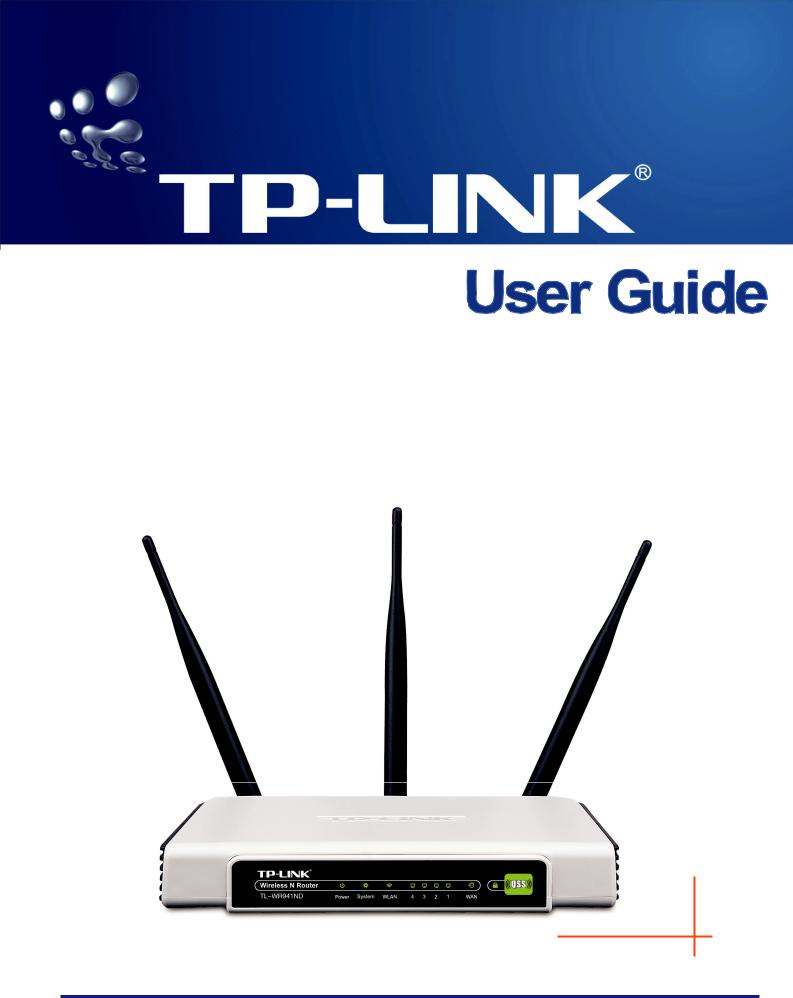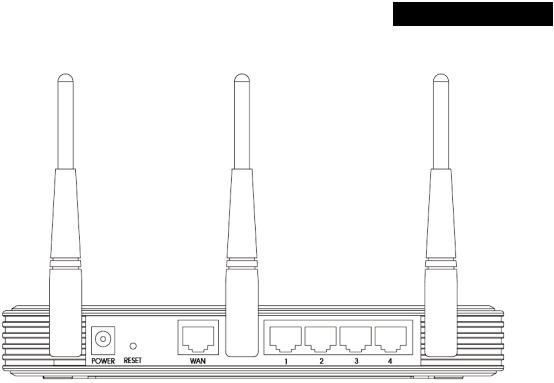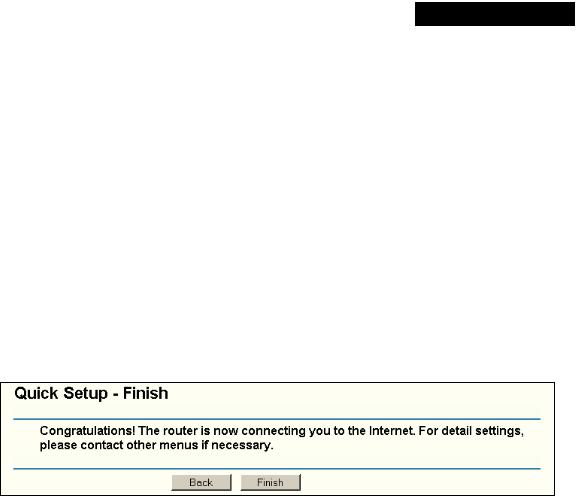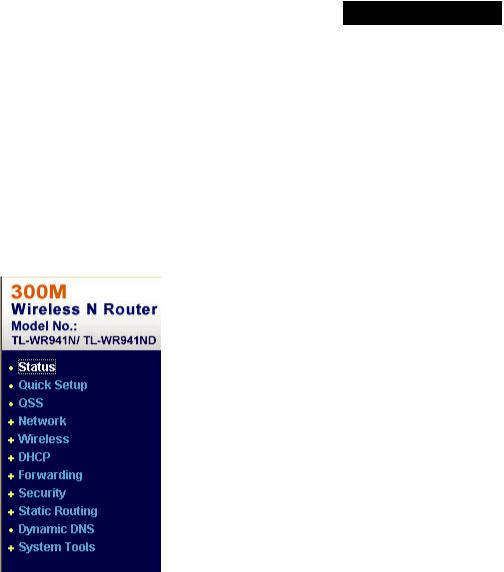TP-Link TL-WR941N, TL-WR941ND User Manual

TL-WR941N
TL-WR941ND
Wireless N Router
Rev: 1.0.0

COPYRIGHT & TRADEMARKS
Specifications are subject to change without notice.  is a registered trademark of TP-LINK TECHNOLOGIES CO., LTD. Other brands and product names are trademarks or registered trademarks of their respective holders.
is a registered trademark of TP-LINK TECHNOLOGIES CO., LTD. Other brands and product names are trademarks or registered trademarks of their respective holders.
No part of the specifications may be reproduced in any form or by any means or used to make any derivative such as translation, transformation, or adaptation without permission from TP-LINK TECHNOLOGIES CO., LTD. Copyright © 2008 TP-LINK TECHNOLOGIES CO., LTD. All rights reserved.
http://www.tp-link.com
FCC STATEMENT
This equipment has been tested and found to comply with the limits for a Class B digital device, pursuant to part 15 of the FCC Rules. These limits are designed to provide reasonable protection against harmful interference in a residential installation. This equipment generates, uses and can radiate radio frequency energy and, if not installed and used in accordance with the instructions, may cause harmful interference to radio communications. However, there is no guarantee that interference will not occur in a particular installation. If this equipment does cause harmful interference to radio or television reception, which can be determined by turning the equipment off and on, the user is encouraged to try to correct the interference by one or more of the following measures:
•Reorient or relocate the receiving antenna.
•Increase the separation between the equipment and receiver.
•Connect the equipment into an outlet on a circuit different from that to which the receiver is connected.
•Consult the dealer or an experienced radio/ TV technician for help.
This device complies with part 15 of the FCC Rules. Operation is subject to the following two conditions:
1)This device may not cause harmful interference.
2)This device must accept any interference received, including interference that may cause undesired operation.
Any changes or modifications not expressly approved by the party responsible for compliance could void the user’s authority to operate the equipment.
- I -

FCC RF Radiation Exposure Statement
This equipment complies with FCC RF radiation exposure limits set forth for an uncontrolled environment. This device and its antenna must not be co-located or operating in conjunction with any other antenna or transmitter.
“To comply with FCC RF exposure compliance requirements, this grant is applicable to only Mobile Configurations. The antennas used for this transmitter must be installed to provide a separation distance of at least 20 cm from all persons and must not be co-located or operating in conjunction with any other antenna or transmitter.”
CE Mark Warning
This is a class B product. In a domestic environment, this product may cause radio interference, in which case the user may be required to take adequate measures.
National restrictions
This device is intended for home and office use in all EU countries (and other countries following the EU directive 1999/5/EC) without any limitation except for the countries mentioned below:
Country |
Restriction |
Reason/remark |
|
|
|
|
|
Bulgaria |
None |
General authorization required for outdoor use and |
|
public service |
|||
|
|
||
|
|
|
Outdoor use limited to 10 France mW e.i.r.p. within the band
2454-2483.5 MHz
Military Radiolocation use. Refarming of the 2.4 GHz band has been ongoing in recent years to allow current relaxed regulation. Full implementation planned 2012
Italy |
None |
If used outside of own premises, general authorization is |
|
required |
|||
|
|
||
|
|
|
|
Luxembourg |
None |
General authorization required for network and service |
|
supply(not for spectrum) |
|||
|
|
||
|
|
|
|
Norway |
Implemented |
This subsection does not apply for the geographical area |
|
within a radius of 20 km from the centre of Ny-Ålesund |
|||
|
|
||
|
|
|
|
Russian Federation |
None |
Only for indoor applications |
|
|
|
|
|
|
|
- II - |
|
|
CONTENTS |
|
Package Contents |
.................................................................................................................................... |
1 |
|
Chapter 1. |
Introduction.......................................................................................................................... |
2 |
|
1.1 |
Overview .........................................................................................................of the Router |
2 |
|
1.2 |
Conventions .......................................................................................................................... |
3 |
|
1.3 |
Main Features ....................................................................................................................... |
3 |
|
1.4 |
Panel .........................................................................................................................Layout |
4 |
|
|
1.4.1 ......................................................................................................... |
The Front Panel |
4 |
|
1.4.2 ......................................................................................................... |
The Rear Panel |
4 |
Chapter 2. Connecting ........................................................................................................the Router |
6 |
||
2.1 |
System ...........................................................................................................Requirements |
6 |
|
2.2 |
Installation ................................................................................Environment Requirements |
6 |
|
2.3 |
Connecting ..........................................................................................................the Router |
6 |
|
Chapter 3. Quick .....................................................................................................Installation Guide |
8 |
||
3.1 |
TCP/IP .............................................................................................................configuration |
8 |
|
3.2 |
Quick ......................................................................................................Installation Guide |
10 |
|
Chapter 4. Configuring .....................................................................................................the Router |
14 |
||
4.1 |
Login ................................................................................................................................... |
|
14 |
4.2 |
Status .................................................................................................................................. |
|
14 |
4.3 |
Quick ........................................................................................................................Setup |
15 |
|
4.4 |
QSS..................................................................................................................................... |
|
16 |
4.5 |
Network............................................................................................................................... |
21 |
|
|
4.5.1 ......................................................................................................................... |
LAN |
21 |
|
4.5.2 ........................................................................................................................ |
WAN |
21 |
|
4.5.3 .............................................................................................................. |
MAC Clone |
26 |
4.6 |
Wireless .............................................................................................................................. |
26 |
|
|
4.6.1 .................................................................................................... |
Wireless Settings |
27 |
|
4.6.2 ..................................................................................................... |
Wireless Security |
28 |
|
4.6.3 ............................................................................................ |
Wireless MAC Filtering |
31 |
|
4.6.4 .................................................................................................. |
Wireless Advanced |
33 |
- III -
|
4.6.5 |
Wireless Statistics ................................................................................................... |
34 |
4.7 |
DHCP |
.................................................................................................................................. |
35 |
|
4.7.1 |
DHCP Settings ........................................................................................................ |
35 |
|
4.7.2 |
DHCP Clients List .................................................................................................... |
36 |
|
4.7.3 |
Address Reservation ............................................................................................... |
37 |
4.8 |
Forwarding .......................................................................................................................... |
38 |
|
|
4.8.1 ......................................................................................................... |
Virtual Servers |
38 |
|
4.8.2 ......................................................................................................... |
Port Triggering |
40 |
|
4.8.3 ......................................................................................................................... |
DMZ |
42 |
|
4.8.4 ....................................................................................................................... |
UPnP |
42 |
4.9 |
Security ............................................................................................................................... |
43 |
|
|
4.9.1 .................................................................................................................... |
Firewall |
43 |
|
4.9.2 ............................................................................................................... |
IP Filtering |
44 |
|
4.9.3 ...................................................................................................... |
Domain Filtering |
47 |
|
4.9.4 ........................................................................................................... |
MAC Filtering |
49 |
4.10 Static Routing...................................................................................................................... |
50 |
||
4.11 Dynamic .....................................................................................................................DNS |
52 |
||
4.12 System .......................................................................................................................Tools |
53 |
||
|
4.12.1 ............................................................................................................Time Setting |
53 |
|
|
4.12.2 .................................................................................................................Firmware |
54 |
|
|
4.12.3 ......................................................................................................Factory Defaults |
55 |
|
|
4.12.4 ...................................................................................................Backup & Restore |
55 |
|
|
4.12.5 .....................................................................................................................Reboot |
56 |
|
|
4.12.6 .................................................................................................................Password |
56 |
|
|
4.12.7 ...............................................................................................................System log |
57 |
|
|
4.12.8 ..............................................................................................Remote Management |
58 |
|
|
4.12.9 ..................................................................................................................Statistics |
58 |
|
Appendix A: FAQ .................................................................................................................................... |
|
60 |
|
Appendix B: Configuring ........................................................................................................the PCs |
65 |
||
Appendix C: Specifications................................................................................................................... |
69 |
||
Appendix D: Glossary............................................................................................................................ |
70 |
||
- IV -

TL-WR941N/TL-WR941ND |
Wireless N Router |
Package Contents
The following items should be found in your package:
¾TL-WR941N/TL-WR941ND Wireless N Router
¾DC Power Adapter for TL-WR941N/TL-WR941ND Wireless N Router
¾Quick Installation Guide
¾Resource CD for TL-WR941N/TL-WR941ND Wireless N Router, including:
•This Guide
•Other Helpful Information
) Note:
Make sure that the package contains the above items. If any of the listed items are damaged or missing, please contact with your distributor.
- 1 -

TL-WR941N/TL-WR941ND |
Wireless N Router |
Chapter 1. Introduction
1.1Overview of the Router
Thank you for choosing the TL-WR941N/TL-WR941ND Wireless N Router.
The TL-WR941N/TL-WR941ND Wireless N Router integrates 4-port Switch, Firewall, NAT-router and Wireless AP. Powered by 3x3 MIMO technology, the Wireless N Router delivers exceptional range and speed, which can fully meet the need of Small Office/Home Office (SOHO) networks and the users demanding higher networking performance.
Incredible Speed
The TL-WR941N/TL-WR941ND Wireless N Router provides up to 300Mbps wireless connection with other 802.11n wireless clients. The incredible speed makes it ideal for handling multiple data streams at the same time, which ensures your network stable and smooth. The performance of this 802.11n wireless router will give you the unexpected networking experience at speed 650% faster than 802.11g. It is also compatible with all IEEE 802.11g and IEEE 802.11b products.
Multiple Security Protections
With multiple protection measures, including SSID broadcast control and wireless LAN 64/128/152-bit WEP encryption, WiFi protected Access (WPA2PSK, WPAPSK), as well as advanced Firewall protections, the TL-WR941N/941ND Wireless N Router provides complete data privacy.
Flexible Access Control
The TL-WR941N/TL-WR941ND Wireless N Router provides flexible access control, so that parents or network administrators can establish restricted access policies for children or staff. It also supports Virtual Server and DMZ host for Port Triggering, and then the network administrators can manage and monitor the network in real time with the remote management function.
Simple Installation
Since the router is compatible with virtually all the major operating systems, it is very easy to manage. Quick Setup Wizard is supported and detailed instructions are provided step by step in this user guide. Before installing the router, please look through this guide to know all the router’s functions.
- 2 -

TL-WR941N/TL-WR941ND |
Wireless N Router |
1.2Conventions
The router or TL-WR941N/TL-WR941ND mentioned in this guide stands for TL-WR941N/TL-WR941ND Wireless N Router without any explanation.
) Note:
The two devices of TL-WR941N and TL-WR941ND are sharing this User Guide. For simplicity, we will take TL-WR941ND for example throughout this Guide,
The differences between them are:
¾TL-WR941N router with three fixed antennas.
¾TL-WR941ND router with three detachable antennas.
1.3Main Features
¾Complies with IEEE 802.11n draft version 2.0 to provide a wireless data rate of up to 300Mbps.
¾One 10/100M Auto-Negotiation RJ45 WAN port, four 10/100M Auto-Negotiation RJ45 LAN ports, supporting Auto MDI/MDIX.
¾Provides WPA/WPA2, WPA-PSK/WPA2-PSK authentication, TKIP/AES encryption security.
¾Shares data and Internet access for users, supporting Dynamic IP/Static IP/PPPoE Internet access.
¾Supports Virtual Server, Special Application and DMZ host.
¾Supports UPnP, Dynamic DNS, Static Routing.
¾Provide Automatic-connection and Scheduled Connection on certain time to the Internet
¾Built-in NAT and DHCP server supporting static IP address distributing.
¾Built-in firewall supporting IP address filtering, Domain Name filtering, and MAC address filtering.
¾Connecting to Internet on demand and disconnecting from the Internet when idle for PPoE..
¾Provides 64/128/152-bit WEP encryption security and wireless LAN ACL (Access Control List).
¾Supports Flow Statistics.
¾Supports firmware upgrade and Web management.
-3 -

TL-WR941N/TL-WR941ND |
Wireless N Router |
1.4Panel Layout
1.4.1 The Front Panel
Figure 1-1 Front Panel sketch
The Router’s LEDs and the QSS button are located on the front panel (View from left to right).
|
Name |
|
Status |
|
|
Indication |
|
Power |
|
Off |
|
Power off |
|
|
|
|
|
|
|
|
|
|
On |
|
|
Power on |
|
|
|
|
|
|
||
|
|
|
|
|
|
|
|
|
|
On |
|
|
The router is initializing or maybe has a system error |
|
System |
|
|
|
|
|
|
|
Flashing |
|
The router is working properly |
||
|
|
|
|
|
|
|
|
|
|
Off |
|
The router has a system error |
|
|
|
|
|
|
|
|
|
WLAN |
|
Off |
|
The Wireless function is disabled |
|
|
|
|
|
|
|
|
|
|
Flashing |
|
The Wireless function is enabled |
||
|
|
|
|
|||
|
|
|
|
|
|
|
|
|
|
Off |
|
There is no device linked to the corresponding port |
|
|
WAN, |
|
|
|
|
|
|
|
On |
|
|
There is a device linked to the corresponding port but no |
|
|
LAN 1-4 |
|
|
|
activity |
|
|
|
|
|
|
||
|
|
|
Flashing |
|
There is an active device linked to the corresponding port |
|
|
|
|
|
|
|
|
|
|
|
Flash(green) |
|
|
There is a wireless device connecting to the network by |
|
|
|
|
|
|
QSS function. |
|
QSS |
|
On(green) |
|
|
There is a wireless device successfully added to the |
|
|
|
|
network by QSS function. |
||
|
|
|
|
|
|
|
|
|
|
|
|
|
|
|
|
|
Flash(red) |
|
|
There is a wireless device failed to add to the network by |
|
|
|
|
|
QSS function. |
|
|
|
|
|
|
|
|
|
|
|
|
|
|
|
|
|
|
|
Table 2-1 The LEDs description |
||
- 4 -

TL-WR941N/TL-WR941ND |
Wireless N Router |
1.4.2 The Rear Panel
Figure 1-2 Rear Panel sketch
The following parts are located on the rear panel (View from left to right).
¾Power socket: The Power socket is where you will connect the power adapter. Please use
the power adapter provided with this TL-WR941N/941ND Wireless N Router.
¾LAN (1,2,3,4): These ports (1, 2, 3, 4) connect the router to the local PC(s).
¾WAN: This WAN port is where you will connect the DSL/cable Modem, or Ethernet.
¾Reset button
There are two ways to reset to the router's factory defaults:
1)Use the Factory Defaults function on System Tools -> Factory Defaults page in the router's Web-based Utility.
2) Use the Factory Default Reset button: Press the Reset button for five seconds and then wait for the router to reboot.
¾ Wireless antenna: To receive and transmit the wireless data.
- 5 -

TL-WR941N/TL-WR941ND |
Wireless N Router |
Chapter 2. Connecting the Router
2.1System Requirements
¾Broadband Internet Access Service (DSL/Cable/Ethernet)
¾One DSL/Cable Modem that has an RJ45 connector (which is not necessary if the router is connected directly to the Ethernet.)
¾PCs with a working Ethernet Adapter and an Ethernet cable with RJ45 connectors
¾TCP/IP protocol on each PC
¾Web browser, such as Microsoft Internet Explorer 5.0 , Netscape Navigator 6.0 or above
2.2Installation Environment Requirements
¾Place the router in a well ventilated place far from any heater or heating vent
¾Avoid direct irradiation of any strong light (such as sunlight)
¾Keep at least 2 inches (5 cm) of clear space around the router
¾Operating Temperature: 0 ~40 (32 ~104 )
¾Operating Humidity: 10%~90%RH, Non-condensing
2.3Connecting the Router
Before installing the router, make sure your PC is connected to the Internet through the broadband service successfully. If there is any problem, please contact your ISP. After that, please install the router according to the following steps. Don't forget to pull out the power plug and keep your hands dry.
1.Power off your PC, Cable/DSL Modem, and the router.
2.Locate an optimum location for the router. The best place is usually at the center of your wireless network. The place must accord with the Installation Environment Requirements.
3.Adjust the direction of the antenna. Normally, upright is a good direction.
4.Connect the PC(s) and each Switch/Hub in your LAN to the LAN Ports on the router, shown in Figure 2-1. (If you have the wireless NIC and want to use the wireless function, you can skip this step.)
-6 -

TL-WR941N/TL-WR941ND |
Wireless N Router |
5.Connect the DSL/Cable Modem to the WAN port on the router, shown in Figure 2-1.
6.Connect the DC power adapter to the DC power socket on the router, and the other end into an electrical outlet. The router will start to work automatically.
7.Power on your PC and Cable/DSL Modem.
Figure 2-1 Hardware Installation of the TL-WR941ND Wireless N Router
- 7 -

TL-WR941N/TL-WR941ND |
Wireless N Router |
Chapter 3. Quick Installation Guide
This chapter will show you how to configure the basic functions of your TL-WR941ND Wireless N Router using Quick Setup Wizard within minutes.
3.1TCP/IP configuration
The default IP address of the TL-WR941ND Wireless N Router is 192.168.1.1. And the default Subnet Mask is 255.255.255.0. These values can be changed as you desire. In this guide, we use all the default values for description.
Connect the local PC to the LAN ports of the router. And then you can configure the IP address for your PC in the following two ways.
¾Configure the IP address manually
1)Set up the TCP/IP Protocol for your PC. If you need instructions as to how to do this, please refer to Appendix B: "Configuring the PC."
2)Configure the network parameters. The IP address is 192.168.1.xxx ("xxx" is any number from 2 to 254), Subnet Mask is 255.255.255.0, and Gateway is 192.168.1.1 (The router's default IP address)
¾Obtain an IP address automatically
1)Set up the TCP/IP Protocol in "Obtain an IP address automatically" mode on your PC. If you need instructions as to how to do this, please refer to Appendix B: "Configuring the PC."
2)Reboot the PC and the router. Then the built-in DHCP server will assign IP address for the PC.
Now, you can run the Ping command in the command prompt to verify the network connection between your PC and the router. The following example is in Windows 2000 OS.
Open a command prompt, and type ping 192.168.1.1, and then press Enter.
¾If the result displayed is similar to the Figure 3-1, it means the connection between your PC and the router has been established well.
- 8 -

|
TL-WR941N/TL-WR941ND |
Wireless N Router |
|
|
|
|
|
|
|
|
|
Figure 3-1 Success result of Ping command
¾If the result displayed is similar to the Figure 3-2, it means the connection between your PC and the router is failed.
Figure 3-2 Failure result of Ping command
Please check the connection following these steps:
1.Is the connection between your PC and the router correct?
) Note:
The 1/2/3/4 LEDs of LAN ports which you link to on the router and LEDs on your PC's adapter should be lit.
2.Is the TCP/IP configuration for your PC correct?
) Note:
If the router's IP address is 192.168.1.1, your PC's IP address must be within the range of 192.168.1.2 ~ 192.168.1.254.
- 9 -

TL-WR941N/TL-WR941ND |
Wireless N Router |
3.2Quick Installation Guide
With a Web-based (Internet Explorer or Netscape® Navigator) utility, it is easy to configure and manage the TL-WR941ND Wireless N Router. The Web-based utility can be used on any Windows, Macintosh or UNIX OS with a Web browser.
1. To access the configuration utility, open a web-browser and type in the default address http://192.168.1.1 in the address field of the browser.
Figure 3-3 Login the router
After a moment, a login window will appear, similar to the Figure 3-4. Enter admin for the User Name and Password, both in lower case letters. Then click the OK button or press the Enter key.
Figure 3-4 Login Windows
) Note:
If the above screen does not pop-up, it means that your Web-browser has been set to a proxy. Go to Tools menu>Internet Options>Connections>LAN Settings, in the screen that appears, cancel the Using Proxy checkbox, and click OK to finish it.
2. After successfully login, you can click the Quick Setup to quickly configure your router.
Figure 3-5 Quick Setup
- 10 -

TL-WR941N/TL-WR941ND |
Wireless N Router |
3. Click Next, and then Choose WAN Connection Type page will appear, shown in Figure 3-6.
Figure 3-6 Choose WAN Connection Type
The router supports three popular ways to connect to Internet. Please select one compatible with your ISP. Click Next to enter the necessary network parameters.
a) If you are provided the ADSL Dial-up service, please choose "PPPoE"(Point-to-Point Protocol over Ethernet), and you will see this page shown in Figure 3-7:
Figure 3-7 Quick Setup - PPPoE
¾User Name and Password - Enter the User Name and Password provided by your ISP. These fields are case sensitive. If you have difficulty with this process, please contact your ISP.
b)If the Router connects to a DHCP server, or the ISP supplies you with DHCP connection, please choose "Dynamic IP", the router will automatically receive the IP parameters from your ISP with no need to enter any parameters.
c)If the IP parameters have been provided by your ISP, please choose "Static IP", and then the Static IP settings page will appear, shown in Figure 3-8.
- 11 -

|
TL-WR941N/TL-WR941ND |
Wireless N Router |
|
|
|
|
|
|
|
|
|
Figure 3-8 Quick Setup - Static IP
¾IP Address - This is the WAN IP address as seen by external users on the Internet (including your ISP). Enter the IP address into the field.
¾Subnet Mask - The Subnet Mask is used for the WAN IP address, it is usually 255.255.255.0
¾Default Gateway - Enter the gateway IP address into the box if required.
¾Primary DNS - Enter the DNS Server IP address into the box if required.
¾Secondary DNS - If your ISP provides another DNS server, enter it into this field.
4. Click Next to continue, the Wireless settings page will appear, shown in Figure 3-9.
Figure 3-9 Quick Setup – Wireless
¾Wireless Radio - Enable or disable the wireless radio choosing from the pull-down list.
¾SSID - Enter a value of up to 32 characters. The same name of SSID (Service Set Identification) must be assigned to all wireless devices in your network. Considering your wireless network security, the default SSID is set to be TP-LINK_xxxxxx (xxxxxx indicates the last unique six numbers of each Router’s MAC address). This value is case-sensitive. For example, TP-LINK is NOT the same as tp-link.
-12 -

TL-WR941N/TL-WR941ND |
Wireless N Router |
¾Region - Select your region from the pull-down list. This field specifies the region where the wireless function of the router can be used. It may be illegal to use the wireless function of the router in a region other than one of those specified in this field. If your country or region is not listed, please contact your local government agency for assistance.
¾Channel - This field determines which operating frequency will be used. The default channel is set to 6. It is not necessary to change the wireless channel unless you notice interference problems with another nearby access point
¾Channel width - Select any channel width from the pull-down list. The default setting is automatic, which can adjust the channel width for your clients automatically.
These settings are only for basic wireless parameters. For advanced settings, please refer to Section 4.5: "Wireless."
5. Click the Next button. You will then see the Finish page:
Figure 3-10 Quick Setup - Finish
After finishing all configurations of basic network parameters, please click Finish button to exit this Quick Setup.
- 13 -

TL-WR941N/TL-WR941ND |
Wireless N Router |
Chapter 4. Configuring the Router
This chapter will show each Web page's key functions and the configuration way.
4.1Login
After your successful login, you will see the eleven main menus on the left of the Web-based utility. On the right, there are the corresponding explanations and instructions.
The detailed explanations for each Web page’s key function are listed below.
4.2Status
The Status page provides the current status information about the router. All information is read-only.
- 14 -

TL-WR941N/TL-WR941ND |
Wireless N Router |
|
|
|
|
|
|
|
Figure 4-1 Router Status
4.3Quick Setup
Please refer to Section 3.2: "Quick Installation Guide."
- 15 -

TL-WR941N/TL-WR941ND |
Wireless N Router |
4.4QSS
This section will guide you add a new wireless device to an existing network quickly by QSS (Quick Secure Setup) function.
a). Choose menu “QSS”, you will see the next screen (shown in Figure 4-2 ). .
Figure 4-2 QSS
¾QSS Status - Enable or disable the QSS function here.
¾Current PIN - The current value of the router's PIN displayed here. The default PIN of the router can be found in the label or User Guide.
¾Restore PIN - Restore the PIN of the router to its default.
¾Gen New PIN - Click this button, and then you can get a new random value for the router's PIN. You can ensure the network security by generating a new PIN.
¾Add device - You can add the new device to the existing network manually by clicking this button.
b). To add a new device:
If the wireless adapter supports Wi-Fi Protected Setup (WPS), you can establish a wireless connection between wireless adapter and router using either Push Button Configuration (PBC) method or PIN method.
) Note:
To build a successful connection by QSS, you should also do the corresponding configuration of the new device for QSS function meanwhile.
For the configuration of the new device, here takes the Wireless Adapter of our company for example.
I.By PBC
If the wireless adapter supports Wi-Fi Protected Setup and the Push Button Configuration (PBC) method, you can add it to the network by PBC with the following two methods.
Method One:
Step 1: Press the QSS button on the front panel of the router.
- 16 -

TL-WR941N/TL-WR941ND |
Wireless N Router |
Step 2: For the configuration of the wireless adapter, please choose Push the button on my access point in the configuration utility of the QSS as below, and click Next.
The QSS Configuration Screen of Wireless Adapter
Method Two:
Step 1: Keep the default QSS Status as Enabled and click the Add device button in Figure 4-2, then the following screen will appear.
Figure 4-3 Add A New Device
- 17 -

TL-WR941N/TL-WR941ND |
Wireless N Router |
Step 2: Choose Press the button of the new device in two minutes and click Connect.. Step 3: For the configuration of the wireless adapter, please choose Push the button on my
access point in the configuration utility of the QSS as below, and click Next.
The QSS Configuration Screen of Wireless Adapter
II. By PIN
If the new device supports Wi-Fi Protected Setup and the PIN method, you can add it to the network by PIN with the following two methods.
Method One: Enter the PIN into my Router
Step 1: Keep the default QSS Status as Enabled and click the Add device button in Figure 4-2, then the following screen will appear.
- 18 -
